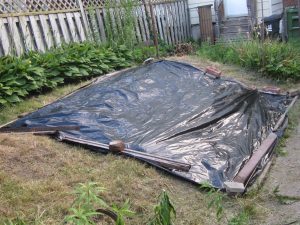
After covering a large area with black plastic, to prepare for mulching, so the area can be dormant for a few season, I had a question about the perimeter flowers which include irises and a transplanted peony.
How much distance from perimeter plants should the black plastic cover be, since the plastic removes light, air and water from the covered part, and may affect the the two adjacent flowers? I thought an 18 inch border was too generous, but then realized this might protect the plants.
As much as I missed the flying insects, birds and lushness of weeds, I want to focus on neglected irises and the transplanted peony, while I can still nuture them back to health, and enjoy some of their future blooms, while looking forward to next season for the other already bloomed flowers who need attention as I complete this project.
Should I keep the plastic as air tight as possible, since air is a nutrient, since it’s been difficult covering a contoured area?
How close can I place plastic close to perimeter flowers without risk to those flowers? I’ll try to attach a photo.
Thank you.
Soil occultation or tarping with black plastic is a great way to rid your soil of weeds and weed seeds. Solarisation (using clear plastic) is another effective option. If your soil was raked and well watered before your plastic was installed, occultation should be at work now that the weather is uniformly warm. Try to keep the edges as tightly covered as possible to keep the moisture in.
The perennials that are sited about 18” away from the black plastic sheeting should be fine. If you are planning to leave them in the same spot, you could provide them with some organic material in the form of compost so that the level of soil nutrients is as high as possible – this will help to nurture them – especially the peony, which can experience stress when transplanted –while you complete your tarping project.

